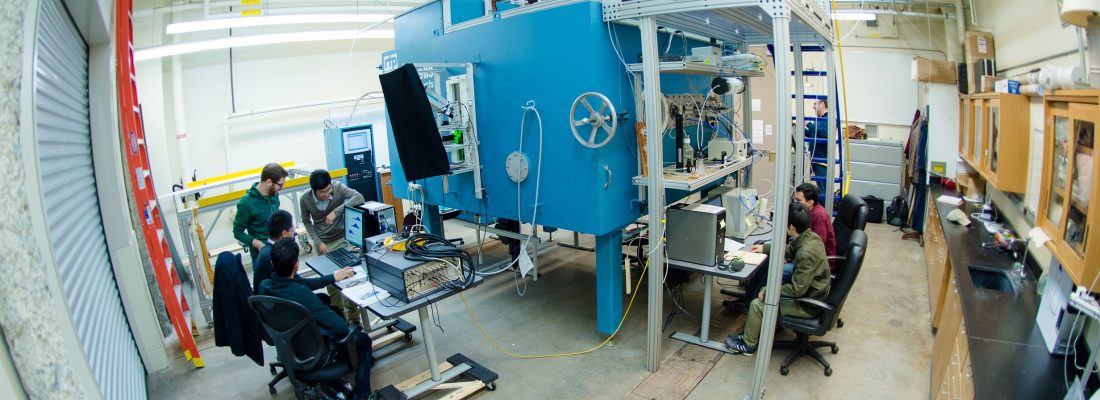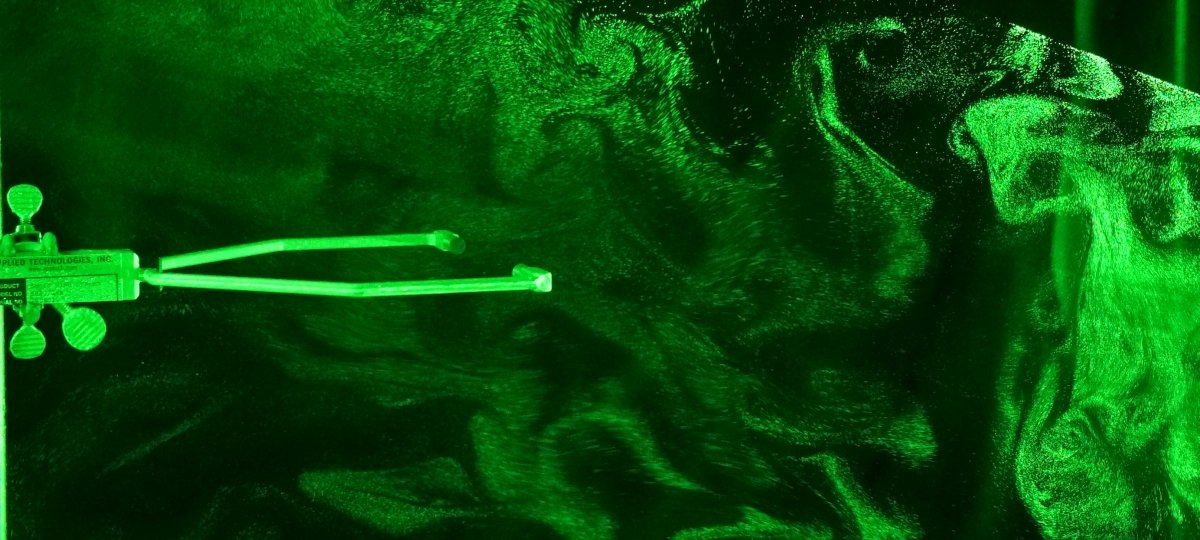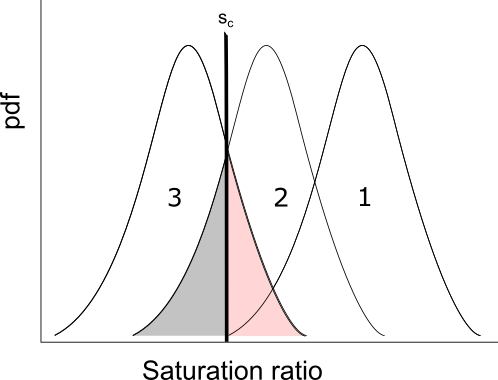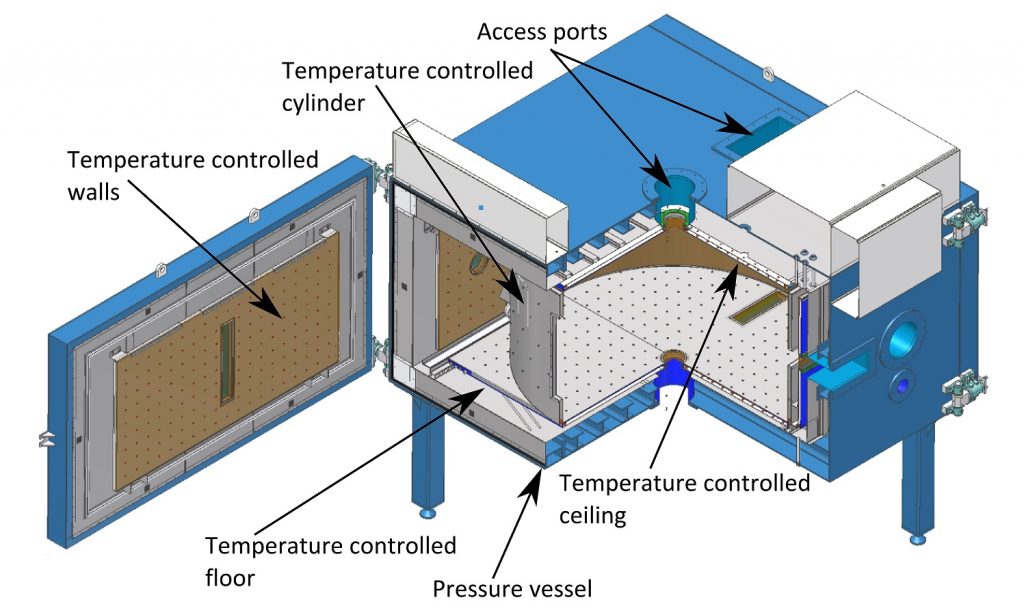
A new paper may sharpen how the effect of turbulence is represented in predictive cloud microphysics models
We all know about clouds, the microphysically complex bunnies, dragons, anvils, and streaks that stream along the vault of the sky. Clouds are also the most visible outward sign of the Earth’s water cycle, which sends water upward by evaporation and downward by condensation.
About aerosols, however: Most of us don’t know much. And turbulence? Not so much again.
The first are tiny solid or liquid particles suspended in a gas that are swept up from the surface of the Earth or created in the atmosphere. They spur the formation of clouds and precipitation and, collectively, help determine the Earth’s radiation budget. Some aerosol particles then “activate” to become cloud droplets.
As for turbulence: This describes pulses of moving air created by wind shear or by contrasts in surface and atmospheric temperatures. Turbulence spins and mixes aerosols in the atmosphere. It also influences the creation of clouds more than previously thought, as a new paper argues.
“Traditionally, large-scale models do not account for turbulence at all. Here, we propose a theoretical framework that can be extended to a global-scale model.” – Prasanth Prabhakaran, MTU
The new study, published in the July 21, 2020 issue of Proceedings of the National Academy of Sciences (PNAS), adds novel insights into how turbulence contributes to aerosol activation and cloud formation. The work was funded by the U.S. Department of Energy’s Atmospheric System Research (ASR) program, as well as by the National Science Foundation (NSF).
Accounting for Turbulence
The lead author is Prasanth Prabhakaran, a postdoctoral researcher in the physics department at Michigan Technological University (MTU). “Traditionally, large-scale models do not account for turbulence at all,” he says, though some cloud-scale models do, at a very high resolution. “Here, we propose a theoretical framework that can be extended to a global-scale model.”
Five MTU colleagues are his co-authors. They include senior author Raymond Shaw, a cloud physicist who directs MTU’s Ph.D. program in atmospheric sciences, and MTU associate provost Will Cantrell, who helped design the university’s cloud-simulation chamber.
Cantrell delivered a flash talk anticipating the paper at the all-virtual June 2020 Joint ARM User Facility/ASR Principal Investigators (PI) Meeting. He cautions that “there are several steps between what we have done (in the paper) and incorporating turbulence into global climate models. But (we are) providing the groundwork and the theory.”
Presently, “anybody trying to do that in a global-scale model is just guessing,” says Cantrell. “We are doing the fundamental work of showing how turbulence activates aerosols in different circumstances.”
Cloud-Droplet Activation

It is important to predict the behavior of clouds since they are so consequential to the atmosphere and life on Earth. Hence the interest in the specks of dust and other matter―the platforms for water and ice that help form clouds.
The PNAS paper takes a new look at an old question related to cloud-behavior predictions: What environmental factors influence the aerosol particles that become cloud droplets?
“If you care about clouds and climate,” says Cantrell, “one of the first questions you ask is: How many cloud droplets are there and how big are they?”
Some aerosols make the transition to cloud droplets when the ambient relative humidity, called the saturation ratio, is greater than a certain critical value. Other factors include particle size and chemical composition. Both are determinants of which aerosol particles will “activate” to become droplets.
Only some aerosols (called cloud condensation nuclei, or CCN) activate to form cloud droplets. The rest remain interstitial particles or “unactivated haze droplets,” which lack the size, solubility, and chemical composition necessary for activation.
“The formation of a cloud droplet is a threshold phenomenon,” says Prabhakaran. “You have to overcome certain barriers first,” including the right relative humidity, or saturation ratio.
The PNAS paper argues that the mean saturation ratio is just one of the environmental conditions influencing the activation of cloud droplets. Another prominent one is turbulence. It can be described as a nuanced continuum of activation conditions―one in which fluctuations in turbulence play, in order, a minimum, intermediate, or the sole role in particle activation.
Adding Turbulence to Models

Using a combination of theory and laboratory experiments, the PNAS co-authors write that there is “a clear transition from a regime in which the mean saturation ratio dominates to one in which the fluctuations determine cloud properties.”
This insight could usher in a new era of predictive cloud models―one in which turbulent fluctuations are better represented. When considering which aerosol particles will become cloud droplets, the authors argue, fluctuations in the saturation ratio must be considered in models alongside the average saturation ratio. And those fluctuations are caused by turbulence.
Present models of how aerosol particles become cloud droplets only consider average, uniform saturation ratios. These take the form of homogenous “parcel calculations.”
The paper’s authors offer a new two-regime theory on how aerosol activation happens in cloud formation. It’s the basis for aerosol-activation parameterizations―representations in models―and offers a way of going beyond the parcel calculations of the past.
From there, says Cantrell, “if you want to develop climate models in a physically meaningful way, you want to base it on the number and type of aerosols you have in that environment.”
The same models should take turbulence into account, he argues, which they do not right now.
The new paper’s proposed theoretical framework provides a way for models to account for turbulence.
Theories in a Cloud Chamber
The need to account for turbulence in cloud formation and droplet activation was the inspiration for the MTU acquiring its Pi Cloud Chamber in 2014, courtesy of a Major Research Instrumentation Program grant from the NSF.
The temperature- and pressure-controlled device, about the size of a delivery truck, houses an interior chamber of 3.14 cubic meters―hence the name “Pi.” (The chamber, one of only two of its kind in the world, was delivered, by chance, March 14: Pi Day.)

“You can study the interactions between a cloud and turbulence in a lab setting,” says Cantrell, “in a well-defined, reproducible manner. Work subsequently funded by ASR would not have been possible without this chamber.”
One advantage such a chamber has is that a simulated cloud can be maintained in it for up to 10 hours. That’s better in many ways than a research jet racing through a cloud at 100 meters a second, taking microphysically random measurements along the way.
“The chamber gives us the ability to observe a cloud for a long time,” says Cantrell. “That is an advantage that is hard to overstate.”
Most modeling is based on field measurements, says Prabhakaran, where “none of the conditions can be controlled. We can control almost every variable of interest here―levels of turbulence, temperature, the phase of cloud droplets (whether they are water or ice), and what aerosol we use.”
As a consequence, “we get really clean data,” he says, which in turn can be used to fine tune parameters in the quest for “better models for cloud microphysical processes.”
In nature, clouds span several kilometers or more, concedes Prabhakaran, and in the chamber, “there is only a small portion. But that’s enough to understand a few key aspects of cloud droplet formation.”
From a Pi Chamber, a PNAS Paper
To experimentally simulate the role turbulence might play in cloud-droplet activation, Prabhakaran and his co-authors created a supersaturated, turbulent environment within the MTU Pi Chamber. They then seeded it with controlled pulses of sodium chloride aerosols to prompt the formation of a cloud under varying conditions.
The origins of the experiment that led to the PNAS paper were in a class Prabhakaran was teaching. MTU physics Ph.D. candidate Abu Sayeed Md Shawon approached him one day with the core idea―that turbulence influences cloud droplet activation. The chamber was there for testing it out.
“That’s one of the nice things about having a facility like this,” says Cantrell of the Pi Chamber. “You can just take a day and set up an experiment.”
In this case, he says, Prabhakaran and Shawon “made it work.” The PNAS paper was the result.
“The chamber gives us the ability to observe a cloud for a long time, 10 hours at a time. That is an advantage that is hard to overstate.” – Will Cantrell, MTU
On the Chamber Drawing Board
Turbulence within clouds remains a research theme at MTU. Cantrell outlined a few current and future pursuits.
Work is already underway on using the Pi Chamber to investigate how light is transmitted and scattered through a turbulent cloud. A paper on the subject, cloud reflectivity, was published on August 7, 2020, in the journal Atmosphere. Cantrell and Shaw are co-authors.
Soon to be underway will be research into how clear air from above is mixed into a cloud, which has “a lot of implications on how long clouds last,” says Cantrell. For one, such air may be dry, which speeds the end of a cloud’s lifespan.
The chamber will also be a key feature of research beginning later this year and led by MTU physics professor Claudio Mazzoleni. His Light Absorbing Aerosol-Cloud Interactions Experiment (LAACI) was one of 31 university-based research projects awarded ASR funding in late July 2020.
Part of that research, over three years, will use the Pi Chamber to study how carbon-based particles are incorporated into clouds and how they are removed.
That research has long a subject of interest. Since turbulence is a factor, “it is quite related to the PNAS investigation,” says Cantrell. “Now, we will definitely do it.”
# # #This work was supported by the U.S. Department of Energy’s Office of Science, through the Biological and Environmental Research program as part of the Atmospheric System Research program.

